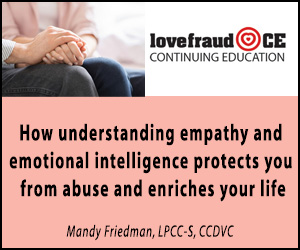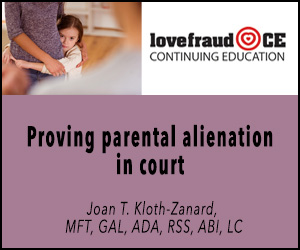DSM-5 diagnostic criteria for the Cluster B personality disorders
Lovefraud uses the word “sociopath” as an umbrella term to cover all of the exploitative personality disorders — antisocial, narcissistic, borderline, histrionic and psychopathic. But what are the traits of each of these disorders?
Dr. Robert Hare, a Canadian psychologist, identified the common characteristics of psychopaths. These are the criteria used by university research psychologists who study the disorder. Lovefraud summarizes Dr. Hare’s characteristics on the following page:
Clinicians who treat patients refer to the diagnostic criteria in the American Psychiatric Association’s Diagnostic and Statistical Manual of Mental Disorders, now in its fifth edition (DSM-5). This book is the bible of the mental health field.
In the DSM-5, “psychopath” is not a recognized diagnosis, and neither is “sociopath.” Rather, the DSM-5 refers to “antisocial personality disorder,” which is similar, but not quite the same.
The DSM-5 includes 10 personality disorders in total, which are divided into Cluster A, Cluster B and Cluster C. Here on Lovefraud, we are describing people with the Cluster B disorders, which are characterized by dramatic, overly emotional or unpredictable thinking or behavior.
Following are the Cluster B personality disorders described in the DSM-5, the estimated prevalence of the disorders, and the diagnostic criteria for each.
Antisocial Personality Disorder
Prevalence: 3.05 to 3.8 percent of the population
Must have shown a pattern of antisocial behavior since at least age 15, and exhibit at least 3 of the following 7 behaviors:
- Failure to conform to social norms, lawful behaviors, acts that are grounds for arrest
- Deceitfulness, lying, conning for profit or self-amusement
- Impulsivity or failure to plan ahead
- Irritability and aggressiveness – physical fights, assaults
- Reckless disregard for safety
- Consistent irresponsibility – failure to work, pay bills
- Lack of remorse – indifferent or rationalizing
Narcissistic Personality Disorder
Prevalence: 1.0 to 6.2 percent of the population
Must show 5 of the following 9 behaviors:
- Grandiose sense of self importance
- Fantasies of unlimited success, power, love
- Belief he/she is special and unique
- Need for excessive admiration
- Sense of entitlement
- Interpersonally exploitative behavior
- Lack of empathy
- Envy of others, or others envy him/her
- Arrogant and haughty behaviors
Borderline Personality Disorder
Prevalence: 1.9 to 5.9 percent of the population
Must show 5 of the following 9 behaviors:
- Frantic efforts to avoid real or imagined abandonment
- Unstable and intense interpersonal relationships
- Identity disturbance
- Impulsivity
- Recurring suicidal behavior
- Emotional instability in reaction to day-to-day events
- Chronic feelings of emptiness
- Inappropriate, intense anger
- Transient, stress-related paranoid or severe dissociative symptoms
Histrionic Personality Disorder
Prevalence: 0.3 to 1.8 percent of the population
Must show 5 of the following 9 behaviors:
- Self-centeredness
- Constantly seeking reassurance or approval.
- Inappropriately seductive appearance or behavior.
- Rapidly shifting emotional states that appear shallow
- Overly concerned with physical appearance
- Opinions are easily influenced by other people
- Excessive dramatics, exaggerated displays of emotion.
- Tendency to believe that relationships are more intimate than they actually are
- Highly suggestible



































